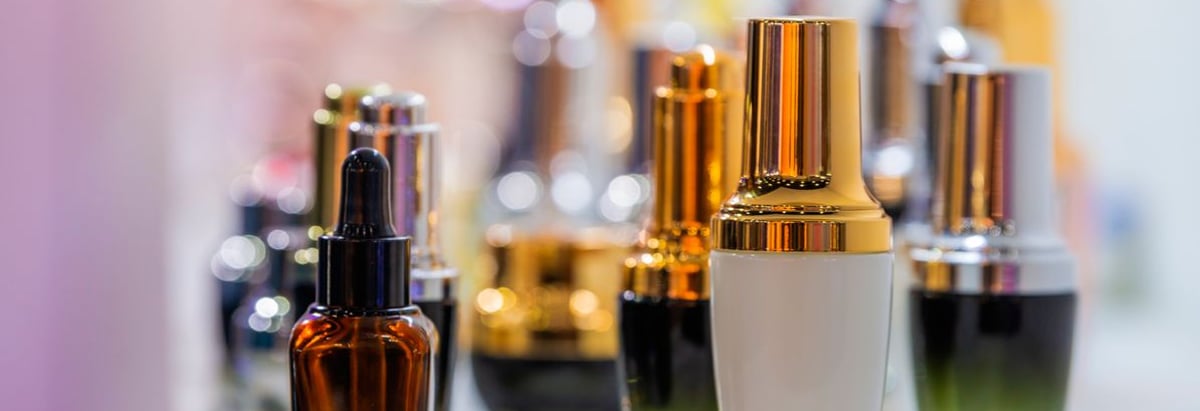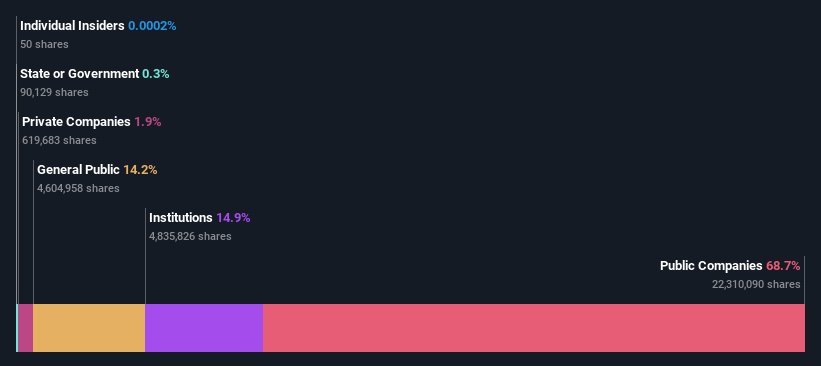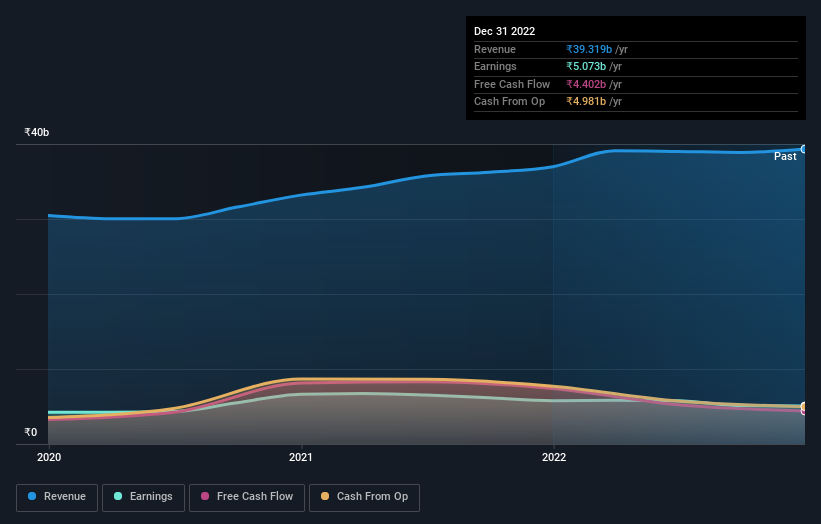- India
- /
- Personal Products
- /
- NSEI:PGHH
Procter & Gamble Hygiene and Health Care Limited's (NSE:PGHH) largest shareholders are public companies with 69% ownership, institutions own 15%

Key Insights
- Procter & Gamble Hygiene and Health Care's significant public companies ownership suggests that the key decisions are influenced by shareholders from the larger public
- The largest shareholder of the company is The Procter & Gamble Company with a 69% stake
- 15% of Procter & Gamble Hygiene and Health Care is held by Institutions
To get a sense of who is truly in control of Procter & Gamble Hygiene and Health Care Limited (NSE:PGHH), it is important to understand the ownership structure of the business. And the group that holds the biggest piece of the pie are public companies with 69% ownership. That is, the group stands to benefit the most if the stock rises (or lose the most if there is a downturn).
Meanwhile, institutions make up 15% of the company’s shareholders. Institutions often own shares in more established companies, while it's not unusual to see insiders own a fair bit of smaller companies.
In the chart below, we zoom in on the different ownership groups of Procter & Gamble Hygiene and Health Care.
See our latest analysis for Procter & Gamble Hygiene and Health Care

What Does The Institutional Ownership Tell Us About Procter & Gamble Hygiene and Health Care?
Institutional investors commonly compare their own returns to the returns of a commonly followed index. So they generally do consider buying larger companies that are included in the relevant benchmark index.
We can see that Procter & Gamble Hygiene and Health Care does have institutional investors; and they hold a good portion of the company's stock. This suggests some credibility amongst professional investors. But we can't rely on that fact alone since institutions make bad investments sometimes, just like everyone does. If multiple institutions change their view on a stock at the same time, you could see the share price drop fast. It's therefore worth looking at Procter & Gamble Hygiene and Health Care's earnings history below. Of course, the future is what really matters.

Procter & Gamble Hygiene and Health Care is not owned by hedge funds. Looking at our data, we can see that the largest shareholder is The Procter & Gamble Company with 69% of shares outstanding. This essentially means that they have extensive influence, if not outright control, over the future of the corporation. SBI Funds Management Limited is the second largest shareholder owning 5.7% of common stock, and Life Insurance Corporation of India, Asset Management Arm holds about 4.5% of the company stock.
While studying institutional ownership for a company can add value to your research, it is also a good practice to research analyst recommendations to get a deeper understand of a stock's expected performance. Our information suggests that there isn't any analyst coverage of the stock, so it is probably little known.
Insider Ownership Of Procter & Gamble Hygiene and Health Care
The definition of an insider can differ slightly between different countries, but members of the board of directors always count. Company management run the business, but the CEO will answer to the board, even if he or she is a member of it.
Insider ownership is positive when it signals leadership are thinking like the true owners of the company. However, high insider ownership can also give immense power to a small group within the company. This can be negative in some circumstances.
Our information suggests that Procter & Gamble Hygiene and Health Care Limited insiders own under 1% of the company. However, it's possible that insiders might have an indirect interest through a more complex structure. Keep in mind that it's a big company, and the insiders own ₹699k worth of shares. The absolute value might be more important than the proportional share. Arguably, recent buying and selling is just as important to consider. You can click here to see if insiders have been buying or selling.
General Public Ownership
The general public-- including retail investors -- own 14% stake in the company, and hence can't easily be ignored. This size of ownership, while considerable, may not be enough to change company policy if the decision is not in sync with other large shareholders.
Public Company Ownership
It appears to us that public companies own 69% of Procter & Gamble Hygiene and Health Care. It's hard to say for sure but this suggests they have entwined business interests. This might be a strategic stake, so it's worth watching this space for changes in ownership.
Next Steps:
It's always worth thinking about the different groups who own shares in a company. But to understand Procter & Gamble Hygiene and Health Care better, we need to consider many other factors. For example, we've discovered 1 warning sign for Procter & Gamble Hygiene and Health Care that you should be aware of before investing here.
Of course this may not be the best stock to buy. So take a peek at this free free list of interesting companies.
NB: Figures in this article are calculated using data from the last twelve months, which refer to the 12-month period ending on the last date of the month the financial statement is dated. This may not be consistent with full year annual report figures.
New: Manage All Your Stock Portfolios in One Place
We've created the ultimate portfolio companion for stock investors, and it's free.
• Connect an unlimited number of Portfolios and see your total in one currency
• Be alerted to new Warning Signs or Risks via email or mobile
• Track the Fair Value of your stocks
Have feedback on this article? Concerned about the content? Get in touch with us directly. Alternatively, email editorial-team (at) simplywallst.com.
This article by Simply Wall St is general in nature. We provide commentary based on historical data and analyst forecasts only using an unbiased methodology and our articles are not intended to be financial advice. It does not constitute a recommendation to buy or sell any stock, and does not take account of your objectives, or your financial situation. We aim to bring you long-term focused analysis driven by fundamental data. Note that our analysis may not factor in the latest price-sensitive company announcements or qualitative material. Simply Wall St has no position in any stocks mentioned.
About NSEI:PGHH
Procter & Gamble Hygiene and Health Care
Engages in the manufacture and sale of branded packaged fast-moving consumer goods in the feminine care and healthcare businesses in India and internationally.
Flawless balance sheet second-rate dividend payer.
Market Insights
Community Narratives



